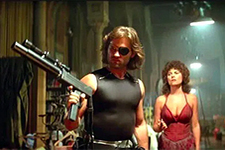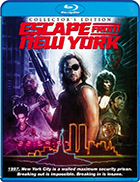Escape From New York
|  There has always been a sense of dystopianism and apocalyptic anxiety in the science fiction genre, and the 1970s—with its worldwide recession, oil shortages, Vietnam conflict, and ever-present tensions between the capitalist West and communist East—helped fuel a special strain of that fixation, which found its way into a series of low-budget movies that dominated B-movie houses and home video shelves in the early 1980s. It was a brief period of particularly acute anxiety, wedged in-between the dying dreams of the ’60s counterculture and the renewed pride of Ronald Reagan’s “Morning in America,” when it seemed more likely than ever that everything—and I mean everything—could go terribly, horribly wrong. Along with George Miller’s Mad Max (1979) and its sequel Mad Max 2 (aka, The Road Warrior, 1981), John Carpenter’s Escape From New York is arguably the best candidate for progenitor of this particularly modern strain of dystopian sci-fi (the fact that Carpenter and co-writer Nick Castle originally penned the screenplay in 1974, the year of Watergate, is telling). The story takes place in the then-futuristic year of 1997, following a third world war and an epic rise in crime that has led the U.S. government to the radical decision of turning the island of Manhattan into a giant federal prison from which no one is allowed to leave. There are no guards inside, only a city-size population of walled-in violent criminals who have developed their own depraved society. Early in the film a radical socialist group hijacks Air Force One and crashes it into the city, hoping to kill the conservative President (Donald Pleasence). The President survives, however, and must be rescued from the city-turned-penitentiary within 24 hours because he is due at an international summit on which the fate of the world hangs. In an act of desperation, police commissioner Bob Hauk (Lee Van Cleef) turns to Snake Plissken (Kurt Russell), a one-eyed special ops veteran-turned-bank robber who was due to be exiled in Manhattan, but may now be the only chance the government has to rescue the President. Snake is sent to the island prison with a stern mandate to find the President and bring him back safely, and just for good measure Haul has a ticking timebomb implanted in his neck. Thus, Snake’s life is on the line from the very first moment; if the crazies in Manhattan don’t get him, the explosives in his arteries will. The majority of the film follows Snake once he is inside the prison, navigating the dark, crumbling concrete jungle and trying to avoid the various roving gangs while tracking down the President, who quickly falls into the hands of The Duke (Isaac Hayes), the leader of the island’s largest gang who wants to use his newfound hostage as a bargaining chip for amnesty. Snake is aided at times by various insiders, including the Brain (Harry Dean Stanton), an untrustworthy snitch who has betrayed Snake in the past; the Brain’s girlfriend Maggie (Adrienne Barbeau); and a cab driver (Ernest Borgnine) who shows up at the narrative’s convenience to provide transportation and escape (there are very few working cars left on the island, and no one has a gun). Like other films of its ilk, there are elements of Escape From New York that have not aged very well, particularly the New Wave-ish synthesizer score that Carpenter concocted alongside his frequent collaborator Alan Howarth, whose primary specialty is in sound design and supervision. The plotting is also somewhat sloppy, with fairly large logic gaps and unanswered questions (like, why would the government build a huge wall around Manhattan, yet leave bridges connecting it to the mainland?). Yet, the film’s powerful, gritty sense of atmosphere remains fresh and effective, making the otherwise absurd idea of turning Manhattan into a prison strikingly credible. The majority of the film was not shot in New York City, but rather in a burnt-out section of downtown St. Louis, which allowed Carpenter and cinematographer Dean Cundey (who had previously shot Carpenter’s Halloween and The Fog) to fill the ’Scope frame with wide, seemingly endless expanses of deserted, trashed-out urban terrain (although not to the extent that the movie poster and subsequent video box promised, as the Statue of Liberty’s head remains firmly attached to her shoulders). In addition to giving the film scope and breadth, the emphasis on terrain also enhances the underlying sense that Carpenter was essentially making a future-punk western, a trick he had pulled several years earlier by redressing Rio Bravo (1959) as an urban nightmare in Assault on Precinct 13 (1976). Kurt Russell’s Snake is essentially a variation on Clint Eastwood’s spaghetti antihero Man With No Name (Eastwood was, not surprisingly, strongly considered for the role), and his extra-stoic take on a criminal lone ranger immediately endeared him to B-movie enthusiasts around the world. With his black eye patch, long hair, five-day stubble, and skin-tight wardrobe, he’s a towering figure of mixed masculine signifiers, which is probably why he doesn’t need to speak much. It is also not surprising that Carpenter cast Lee Van Cleef, best known for his roles in westerns such as High Noon (1950), The Man Who Shot Liberty Valance (1962), and The Good, the Bad, and the Ugly (1966), to play a variation on the weak town sheriff who must use the western hero to get the dirty work done. The result is a film that works on multiple levels: an enthralling, if sometimes inadvertently cheesy adventure yarn, an intriguing window into the fears and anxieties of the early Reagan years, and a film-lover’s cavalcade of genre mash-up, which makes it not at all surprising that Escape From New York has become such a beloved cult item.
Copyright © 2021 James Kendrick Thoughts? E-mail James Kendrick All images copyright © Shout! Factory | |||||||||||||||||||||||||||||
Overall Rating: 

 (3)
(3)


